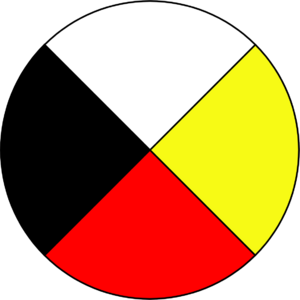Medicine wheel (symbol) facts for kids
The modern Medicine Wheel symbol is a special design that was created around 1972. It was made by a writer named Charles Storm, also known as Hyemeyohsts Storm. Since then, many people have used this symbol. It can represent different ideas, some based on Native American religions. Other ideas are newer and come from New Age beliefs. It is also a common symbol in some groups that bring together different pan-Indian traditions. It is also used in some twelve-step recovery groups that help people.
How the Modern Symbol Started
Charles Storm, who wrote as Hyemeyohsts Storm, created the modern Medicine Wheel symbol around 1972. He was the son of a German immigrant and said he was Cheyenne. He used and changed Native American teachings and symbols from different cultures. For example, he used some ideas from the Plains Sun dance.
Later, a New Age spiritual leader named Vincent LaDuke also started using the Medicine Wheel symbol. He was of Ojibwe descent. LaDuke combined the basic idea with parts of different spiritual practices from various First Nations cultures. He also added ideas from New Age and occult spiritualism.
LaDuke wrote newsletters and books himself. He started a group of followers called the Bear Tribe and called himself their medicine chief. People paid money to attend his workshops and join his "tribe." They could also buy special titles and honors. These titles are usually given to respected elders and knowledge keepers in traditional cultures. Because of these actions, some traditional Native American groups disagreed with LaDuke's teachings.
Some people have called Storm and LaDuke "plastic medicine men." Traditional Native people and activists have said that these people and others who use the symbol for their own ideas are changing traditional teachings. They say this can harm and replace the true ways for money. Other people using the symbol for profit have added ideas from ancient Greek and Persian philosophy. They have also included ideas from colonialism, Hinduism, what they claim is Celtic symbolism, or concepts from New Religious Movements like Wicca.
What the Medicine Wheel Symbol Means
Some of the symbols and teachings used with certain Medicine Wheel versions might come from First Nations cultures. These specific teachings might be hundreds or even thousands of years old. However, critics say that when the symbol is used in a general pan-Indian way, it can easily change the unique, traditional teachings of different tribes and Nations. Sometimes, it can even replace traditional ways with new, fake ones.
Writers who follow New Age ideas often see the Medicine Wheel as a tool for personal growth. They use a special version with the circle divided into colored sections. They assign different personal qualities to these colors and sections. This idea is very different from the Indigenous view. For Indigenous people, ceremonies and sacred places are about the whole community, not just one person.
In most versions, the four sections of the symbol can represent many things. They might stand for the four cardinal directions. They could also mean the four stages of life. Sometimes, they represent four "races of humanity" or four "important virtues." The symbol is always being reinterpreted for different reasons. However, there are many common ways to understand the Medicine Wheel, as you can see below:
| Color | Cardinal direction | Element | "Race" | Celestial body | Time of day | Stage of life | Season | Virtue | Natural component | Sacred medicine |
|---|---|---|---|---|---|---|---|---|---|---|
| White | North | Air | White | Stars | Midnight | Death | Winter | Intellect - mind | Animal | Sweetgrass |
| Yellow | East | Fire | Asian | Sun | Dawn | Growth | Spring | Emotional - heart | Mineral | Tobacco |
| Red | South | Water | Indigenous | Moon | Noon | Birth | Summer | Spiritual - soul | Plant | Cedar |
| Black | West | Earth | Black | Earth | Dusk | Maturity | Autumn | Physical - body | Human | Sage |
See also
- Dreamcatcher
- The red road
- Pan-Indianism



